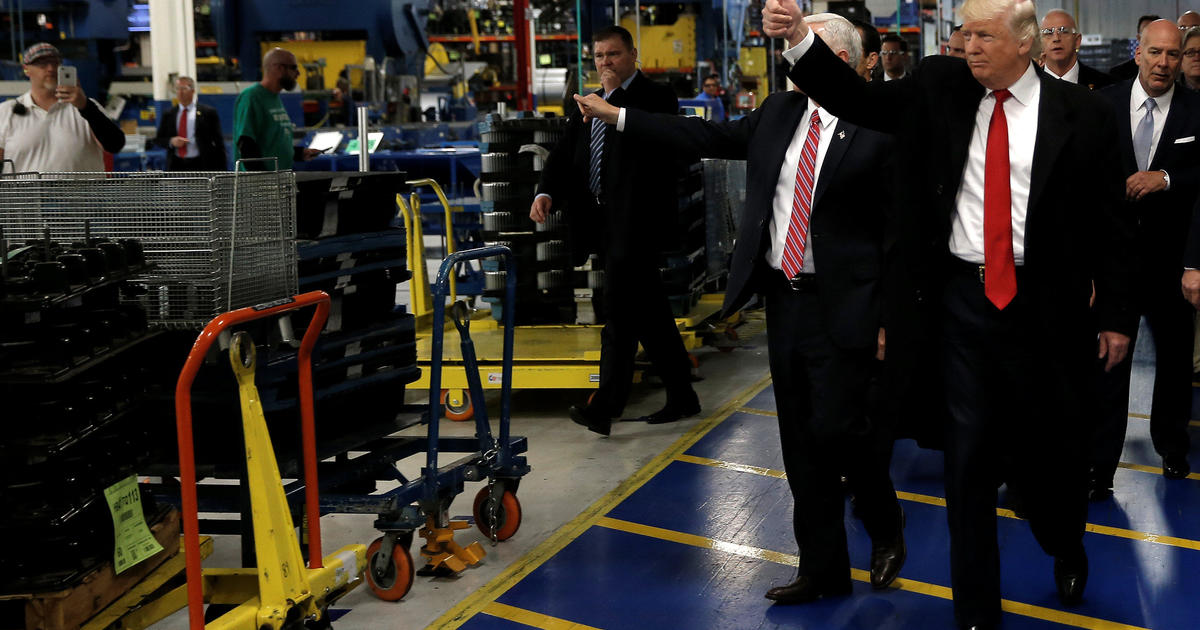 During Donald Trump’s whirlwind first week in office, one thing was apparent: He’s dead serious about putting his hard-line prescriptions for the U. S. into practice — ideas that would alter the American economic landscape, for good or ill.
During Donald Trump’s whirlwind first week in office, one thing was apparent: He’s dead serious about putting his hard-line prescriptions for the U. S. into practice — ideas that would alter the American economic landscape, for good or ill.
The result could be a topsy-turvy country where an activist government — the traditional hallmark of Democrats — is trying to impose conservative goals while also forcing Republicans to swallow things like higher federal spending and budget deficits.
In addition, it’s an America where the customary, if sometimes dysfunctional, norms no longer apply. These include free trade, corporate liberty to send jobs where the cost is lowest and a tax code laden with deductions.
“This is a case of government on your back, micromanaging,” said economist Dennis Hoffman, a professor at Arizona State University who has voted for both Republicans and Democrats in national contests. “The government will tell you who you can hire and who you can source your products from.”
With his party holding majorities in both the Senate and the House of Representatives, Mr. Trump likely will get much of what he wants, in some form. At the congressional Republicans’ gathering in Philadelphia on Thursday, the president’s ideas met with approval and applause.
Alan Murray, Fortune editor-in-chief and Time Inc.’s chief content officer, joins „CBS This Morning“ to discuss trade, immigration and how execut…
Even his call for a $1 trillion program to rebuild the nation’s infrastructure seems to be gaining traction among Republican budget hawks. This comes despite past GOP opposition to such a plan pushed by President Barack Obama — which Republicans derided as a budget-busting boondoggle.
On trade, jobs and taxes, his first week showed Mr. Trump is keeping his word from the election campaign. While his tough prescriptions could bring better deals for U. S. consumers and taxpayers, they carry large potential downsides.
With trade, the new president’s goal is to reverse the nation’s deficit with the rest of the globe. Now, America imports more goods and services than it exports. His method is as tough as it is straightforward: Renegotiate trade treaties and, failing that, impose high tariffs on imports. Such a confrontational course risks higher prices for U. S. consumers and a disruption of global trade that could harm the U. S. economy.
By the same token, his campaign to increase American job growth could prove enormously costly in terms of the federal deficit and the national debt.
The same trade-off exists for his plan to slash both corporate and personal tax rates: More money would be in pockets for spending, and Washington would be deeper in red ink.
Here’s how Mr. Trump may alter the American economic status quo:
In his inaugural address, he lambasted what he sees as one-sided trade that harms U. S. workers. “The wealth of our middle class has been ripped from their homes and distributed around the world,” he said.
Last week, Mr. Trump ordered the construction of a massive wall along the U. S. Southern border border, a notion that was a staple of his campaign oratory, and his press secretary floated the idea of a 20 percent tax on imports from Mexico. The president followed that by picking a Twitter fight with Mexican President Enrique Peña Nieto that led to a cancellation of their planned meeting.
President Trump signed three presidential memos Monday, including nixing U. S. joining the Trans-Pacific Partnership. His press secretary also hel…
No doubt about it: Mexico sells the U. S. more than it buys from the U. S., to the tune of $61 billion. When the two nations (along with Canada) enacted the North American Free Trade Agreement in 1993, the U. S. has a $1.7 billion surplus with its Southern neighbor. Now Mr. Trump wants to renegotiate the pact, something the Mexicans are not eager to do.
The president has stuck to his campaign trail pledge that he would make Mexico pay for his proposed wall, which is designed to keep its citizens from illegally entering the U. S. However, Mexican politicians and its public don’t want to spend a single peso on such a venture. So lately, Mr. Trump is saying the U. S. will pay to build it and get Mexico to pay up in other ways — perhaps by using tariff proceeds.
The wall won’t be cheap: up to $25 billion. The Committee for a Responsible Federal Budget estimates that amounts to $120 per U. S. household.
Meanwhile, China has long enjoyed a huge trade surplus with the U. S., which has grown from around $84 billion in 2000 to $337 billion in 2015. That’s why Mr. Trump has proposed slapping a tariff on Chinese imports of as much as 45 percent, up from the current 3 percent.
Amid all this, the president made what appears to be a contradictory move: He withdrew the U. S. from the Trans-Pacific Partnership trade agreement. The TPP aimed to reduce trade barriers with seven nations on the other side of the Pacific: Japan, Vietnam, Malaysia, Singapore, Australia, Brunei and New Zealand.
Absent from the pact was China, and many viewed the TPP as a means of containing Beijing’s regional economic influence. With the TPP all but dead, China is pursuing its own Asia-Pacific trade agreement, excluding the U. S. from the table. But Mr. Trump is convinced — as was his Democratic opponent, Hillary Clinton — that the TPP wouldn’t protect American jobs.
Aside from cheaper labor overseas, the motive to ship the jobs out of America is to get a lower tax bill. Washington taxes them far more — a maximum 35 percent, although with deductions, it’s lower — than many foreign governments do.
President Trump signed three executive orders on his first Monday in office, one of them on the U. S. withdrawal from the Trans-Pacific Partnershi…
Right now, the U. S. taxes net income for American corporations, regardless of where in the world it is earned. This encourages them to shift production offshore and to keep their profits overseas. For that reason, Mr. Trump wants to lower the U. S. corporate rate.
House Republicans, however, are floating a remedy called a “border adjustment,” which is meant to boost exports and push down imports. The method sounds simple enough: Imports are taxed and exports aren’t.
But then it gets complex. Pantheon Economics’ chief economist Ian Shepherson noted that American businesspeople traveling overseas would be taxed on their expenses. At the same time, he asked, “And how would foreign tourists receive a credit for their spending in, say, U. S. restaurants?” And some import-dependent American companies, like apparel retailers, would be harmed.
As a consequence, Mr. Trump initially rejected the border-adjustment concept as “too complicated.” Then on Thursday, White House chief of staff Reince Priebus said it was part of a “buffet” of options the White House would consider. Where the president and Capitol Hill end up remains to be seen, but Mr. Trump and Republican lawmakers appear eager to do something.
Beyond that, Mr. Trump’s drive to chastise companies that push production overseas has born fruit — in that several he has criticized have knuckled under. The question is whether one-off attacks, often launched by Mr. Trump on Twitter, will be effective in a vast $19 trillion economy, which would entail zeroing in on hundreds of corporate behemoths.






